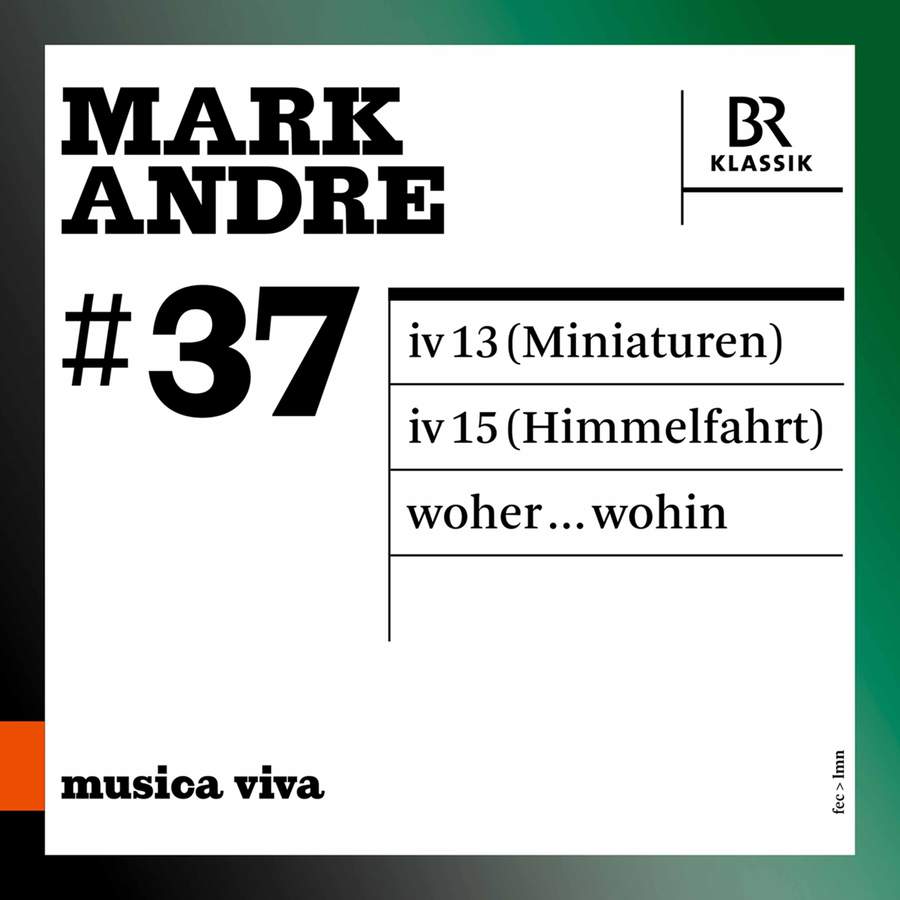ANDRÉ Musica Viva
View record and artist detailsRecord and Artist Details
Genre:
Instrumental
Label: BR Klassik
Magazine Review Date: 10/2021
Media Format: CD or Download
Media Runtime: 67
Mastering:
DDD
Catalogue Number: 900637

Tracks:
| Composition | Artist Credit |
|---|---|
| iv 13 |
Mark André, Composer
Arditti Quartet |
| iv 15 (Himmelfahrt) |
Mark André, Composer
Stephan Heuberger, Organ |
| Woher...Wohin |
Mark André, Composer
Matthias Pintscher, Conductor Symphonieorchester des Bayerischen Rundfunks |
Author: Liam Cagney
Mark Andre (b1964) waited a long time before composing his first string quartet, iv 13 (Miniaturen). A clear reference is Webern’s Six Bagatelles. There is pointillism – hyper-pointillism, even, since the points aren’t pitched notes but slighter slivers of sound – as well as crystalline flashes. Webern’s residual lyricism, though, is absent. Andre’s is a music devoid of feature yet beautiful for all that.
The Arditti Quartet’s interpretation is as perspicuous as always. Andre devised many unconventional playing techniques for these miniatures, ranging from inventive use of mutes to coining different categories of tremolo and trill to precisely measuring different articulations’ graininess. The control over his material is absolute, and in this regard if not in the musical style, we can perhaps observe the legacy of Andre’s teacher, Gérard Grisey.
iv 15 (Himmelfahrt) for solo organ (again, Andre’s first mature work for that instrument) explores transcendence in the Christian sense. In the opening minutes, a slow sound mass evolves, swells, brightens and darkens, as indistinct as the presence of the divine. Thereafter, clearer notes enter, albeit blurred with trills and with disorientating registral shifts; eventually, a strident climax makes use of the church’s resonance. Messiaen inevitably comes to mind, though this is less colourful stained glass than muted light and shade. Stephan Heuberger gives a focused, meditative performance on the Beckerath organ of Munich’s Church of St Ludwig.
The score of woher … wohin for orchestra is prefaced by an excerpt from the Gospel of St John (‘the wind bloweth where it wants to’, etc). Andre opens the work with wind and breath sounds across the orchestra that recall these lines, and woher … wohin is divided into seven parts, a number of theological significance.
Andre is undoubtedly one of the best composers in this quiet, extended-technique-exploring, noise-based idiom, but having heard much stylistically similar music recently, I can’t help wondering if he’s a victim of his success. In Germany this idiom is becoming ubiquitous (and it’s growing in the US) to the point of being a new mannerism.
Discover the world's largest classical music catalogue with Presto Music.

Gramophone Digital Club
- Digital Edition
- Digital Archive
- Reviews Database
- Full website access
From £8.75 / month
Subscribe
Gramophone Full Club
- Print Edition
- Digital Edition
- Digital Archive
- Reviews Database
- Full website access
From £11.00 / month
Subscribe
If you are a library, university or other organisation that would be interested in an institutional subscription to Gramophone please click here for further information.




